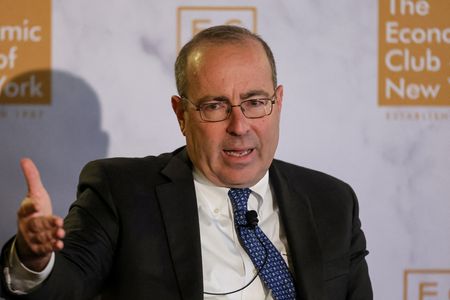By Howard Schneider
COLUMBIA, South Carolina (Reuters) -Finishing the battle against inflation will likely require a hit to demand, after a year in which U.S. price pressures cooled largely through improvements in the supply side of the economy with virtually no change in the unemployment rate, Richmond Federal Reserve President Thomas Barkin said on Monday.
“We got a lot of benefit last year on the supply side,” Barkin said, noting a rise in immigration and a jump in productivity as forces that allowed the economy to grow fast and add jobs while allowing inflation to fall quickly.
But with the pace of price increases possibly stalled at a rate above the Fed’s target, “I do tend to imagine that we’re going to need a little more edge off of demand to get all the way” back to target, Barkin said in comments to reporters after an event at the Columbia Rotary Club.
He said he is “optimistic” that the current level for the benchmark policy rate, held in a range of from 5.25% to 5.5% since July, will be adequate to do the job, and that he doesn’t see the economy overheating.
But he also said his sense of the risks facing the Fed are weighted towards inflation proving tougher to tame than expected.
“I still have the weight going toward inflation,” Barkin said. “It’s a stubborn road back…It doesn’t mean you won’t get it back. It just means it takes a while…to corral price setters into believing they don’t really have a chance” for aggressive increases.
Barkin is a voter this year on interest rate policy, and supported the Fed’s decision at its meeting last week to hold rates steady.
His comments about demand suggest that the final phase of inflation control may hinge on the sort of blow to economic growth – and by implication the job market – that policymakers have been hoping to avoid.
As of March the Fed’s preferred measure of inflation, the personal consumption expenditures price index, was rising at a 2.7% annual rate – far below the peaks seen in 2022, but largely stalled through the first months of the year.
Barkin said he still viewed demand in the economy as strong, but added that the sort of slowdown needed to finish the Fed’s inflation battle needn’t be all that deep.
“If the economy does cool, it doesn’t need to be as painful” as the sharp slowdown seen from 2007 to 2009, for example, he said.
Because the economy seems so resilient, with the unemployment rate at 3.9% and job growth perhaps beginning to fall more in line with pre-pandemic levels, Barkin said the Fed could afford to wait and be sure inflation will resume its decline.
The start of the year “has only confirmed the value of the Fed being deliberate,” said Barkin in his address. “The economy is moving toward better balance, but no one wants inflation to reemerge. We have said we want to gain greater confidence that inflation is moving sustainably toward our 2% target. And given a strong labor market, we have time to gain that confidence.”
(Reporting by Howard Schneider; Editing by Andrea Ricci)











